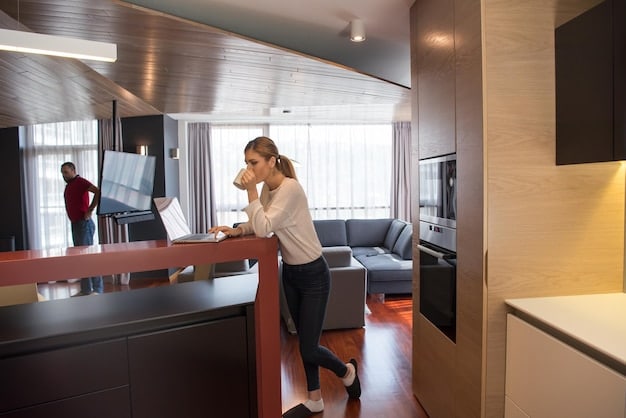Remote Work’s Impact: US Travel Trends in 2025

The rise of remote work is poised to significantly reshape US travel trends in 2025, influencing preferred destinations, trip durations, and the overall purpose of travel as individuals blend work and leisure in new ways.
The shift towards remote work has been a significant societal change, and its effects are now extending into the travel industry. What impact will the rise of remote work have on US travel trends in 2025? It’s a question that’s reshaping how Americans plan their vacations and business trips.
The Evolution of Work and Travel
The traditional boundaries between work and leisure are blurring, creating new opportunities and challenges for the travel industry. Remote work has empowered individuals to design their lives more flexibly, which directly impacts travel preferences and behaviors.
The Rise of the ‘Workation’
One of the most noticeable trends is the increase in ‘workations,’ where people combine work and vacation time. This trend is fueled by the desire to escape the confines of traditional offices and experience new environments while staying productive.
Longer Stays and Flexible Itineraries
Remote workers often have the flexibility to extend their stays in destinations, leading to longer trips and more immersive experiences. This shift benefits local economies and changes the demand for different types of accommodations and services.

Here are some key changes we’re seeing:
- Increased Demand for Extended Stay Options: Hotels and rentals offering weekly or monthly rates are becoming more popular.
- Emphasis on Wi-Fi and Connectivity: Reliable internet access is a must-have for remote workers, influencing destination choices.
- Demand for Work-Friendly Amenities: Co-working spaces, ergonomic furniture, and quiet areas are becoming increasingly important in accommodations.
In conclusion, the evolution of work is intricately linked to the evolution of travel, with remote work driving demand for flexible, longer, and more immersive travel experiences.
Destination Preferences: Beyond the Tourist Traps
Remote work is influencing travelers to explore destinations beyond the typical tourist hotspots. With the ability to work from anywhere, individuals are seeking out locations that offer a blend of natural beauty, cultural experiences, and affordability.
The Appeal of Smaller Cities and Rural Areas
Many remote workers are drawn to smaller cities and rural areas that offer a slower pace of life, lower cost of living, and access to outdoor activities. These destinations provide a respite from the crowds and stresses of urban living.
Emerging Travel Hotspots
Destinations with strong internet infrastructure, appealing local culture, and access to nature are emerging as popular choices for remote workers. These locations often offer unique experiences that combine work and leisure seamlessly.
Here are a few ways destination preferences are changing:
- Increased Interest in Outdoor Activities: Hiking, biking, and water sports are driving destination choices for remote workers.
- Emphasis on Local Experiences: Travelers are seeking out authentic cultural experiences and opportunities to connect with local communities.
- Affordability as a Key Factor: Remote workers are often budget-conscious and prioritize destinations that offer good value for money.
In conclusion, destination preferences are evolving beyond traditional tourist traps as remote workers seek out locations that offer a balance of work, leisure, and local experiences.
The Impact on Accommodation and Hospitality
The rise of remote work is having a profound impact on the accommodation and hospitality industries. Hotels, resorts, and rental properties are adapting to meet the needs of remote workers by offering new amenities, services, and packages.
Adapting to the Needs of Remote Workers
Accommodations are increasingly catering to remote workers by offering dedicated workspaces, high-speed internet, and business services. These amenities make it easier for travelers to stay productive while on the road.
The Rise of Co-Living and Co-Working Spaces
Co-living and co-working spaces are becoming increasingly popular among remote workers. These spaces provide a sense of community, networking opportunities, and a productive work environment.

Here are some key changes in accommodation and hospitality:
- Integration of Workspaces: Hotels and rentals are incorporating dedicated workspaces into their rooms and common areas.
- Enhanced Connectivity: High-speed internet and reliable Wi-Fi are now essential amenities for remote workers.
- Flexible Booking Options: Accommodations are offering flexible booking options and longer-stay discounts to attract remote workers.
In conclusion, the accommodation and hospitality industries are evolving to meet the demands of remote workers by providing the amenities, services, and flexibility they need to stay productive while traveling.
Technology’s Role in Facilitating Remote Travel
Technology plays a crucial role in facilitating remote travel by providing the tools and resources needed to stay connected, productive, and informed. From high-speed internet to mobile apps, technology is making it easier than ever to work and travel simultaneously.
Connectivity and Communication
Reliable internet access and communication tools are essential for remote workers. Destinations with strong internet infrastructure are becoming more attractive, and mobile apps are making it easier to stay connected with colleagues and clients.
Productivity Tools and Resources
A wide range of productivity tools and resources are available to help remote workers stay organized, focused, and efficient. These tools include project management software, collaboration platforms, and time-tracking apps.
Here’s how technology is enabling remote travel:
The Influence of Digital Nomad Communities
Online communities and forums are important for digital nomads and remote workers to share tips, network, and find support. These communities foster collaboration.
- Mobile Apps for Travel Planning: Apps help finding flights, accommodations, and local experiences.
- Virtual Collaboration Platforms: Tools enable remote collaboration, sharing documents, and real-time communication.
In conclusion, technology is a key enabler of remote travel, providing the tools and resources individuals need to stay connected, productive, and informed while working from anywhere.
Economic Impacts on Local Communities
The rise of remote work can have significant economic impacts on local communities, both positive and negative. Remote workers can bring new income and spending to local economies, but they can also put pressure on housing markets and infrastructure.
Increased Spending in Local Economies
Remote workers often spend money on local goods and services, such as food, transportation, and entertainment. This influx of spending can boost local economies and support small businesses.
The Housing Market and Infrastructure Challenges
The influx of remote workers can drive up housing prices and rents in certain areas, making it more difficult for local residents to afford housing. Increased demand can strain local infrastructure, such as roads, water systems, and internet networks.
Here are some economic considerations:
- Job Creation: Remote workers can create new job opportunities in local communities by hiring local service providers and freelancers.
- Tax Revenue: Increased spending can generate more tax revenue for local governments, which can be used to fund public services and infrastructure improvements.
- Community Development: Remote work can contribute to community development by attracting new residents and businesses to local areas.
In conclusion, remote work can have significant economic consequences to local communities, and its key for them to consider both the opportunities and challenges for sustained, balanced growth.
Sustainability and Responsible Travel
Remote work provides travelers with opportunities to minimize the environmental impact while supporting mindful and ethical tourism choices. It’s a chance to be more environmentally conscious without sacrificing travel.
Reducing Travel Frequency and Carbon Footprint
By working remotely, individuals may reduce frequent commutes or business trips. Extended stays in one destination, while working remotely, can minimize overall carbon emissions.
Supporting Local and Sustainable Businesses
Remote workers can choose to support local businesses and services that prioritize sustainability. This could be anything from local restaurants to eco-friendly accommodations, minimizing their impact.
Strategies for sustainable travel:
- Choosing Eco-Friendly Accommodations: Stay in hotels that prioritize energy efficiency, waste reduction, and conservation.
- Reducing Transportation Impact: Utilize public transportation where possible to reduce harmful emissions.
- Supporting Local Agriculture: Shop from farmers markets. This minimizes carbon footprint and ensures higher-quality food.
In conclusion, remote work has environmental benefits, and individuals can leverage this to minimize their ecological effect and support businesses focused on sustainable development.
| Key Point | Brief Description |
|---|---|
| 🌍 Destination Diversification | Remote work expands travel destinations beyond typical tourist spots. |
| 🏢 Accommodation Evolution | Hotels adapt with workspaces & better connectivity for remote workers. |
| 💼 Work-Life Integration | The ‘workation’ trend blends professional duties with leisure activities. |
| 🌱 Sustainability | Longer stays at a single location can reduce environmental impact. |
Frequently Asked Questions
▼
Remote work can reduce the need for frequent commutes, leading to a decrease in short trips. It has increased lengthier stays for remote work purposes while maintaining travel.
▼
Critical amenities in remote work accommodations include fast internet, dedicated workspace, ergonomic chairs, and quiet zones to facilitate work productivity.
▼
Traditional tourist destinations remain relevant but are now competing with smaller cities and rural locales that provide immersive cultural experiences.
▼
An influx of remote workers can increase business to local services, but can also place pressure on the prices for housing and local infrastructures for the original locals.
▼
Yes, by supporting local businesses such as restaurants and local services, remote workers minimize their environmental footprint by minimizing waste.
Conclusion
In conclusion, the rise of remote work is significantly reshaping US travel trends in 2025. From destination preferences and accommodation options to economic impacts and sustainability considerations, these changes are creating new opportunities and challenges for travelers and the travel industry alike. Staying informed and adaptable will be key to navigating this evolving landscape.





